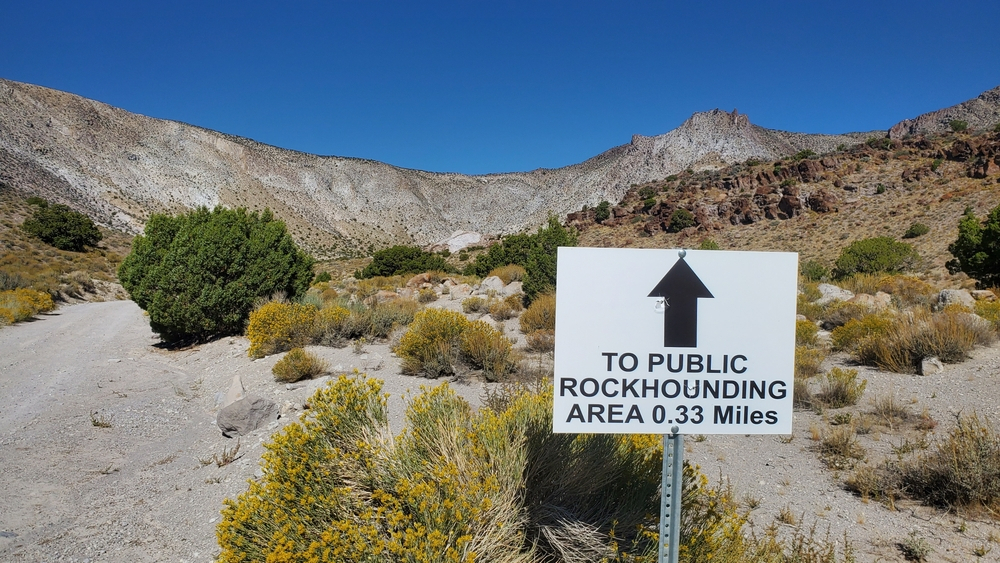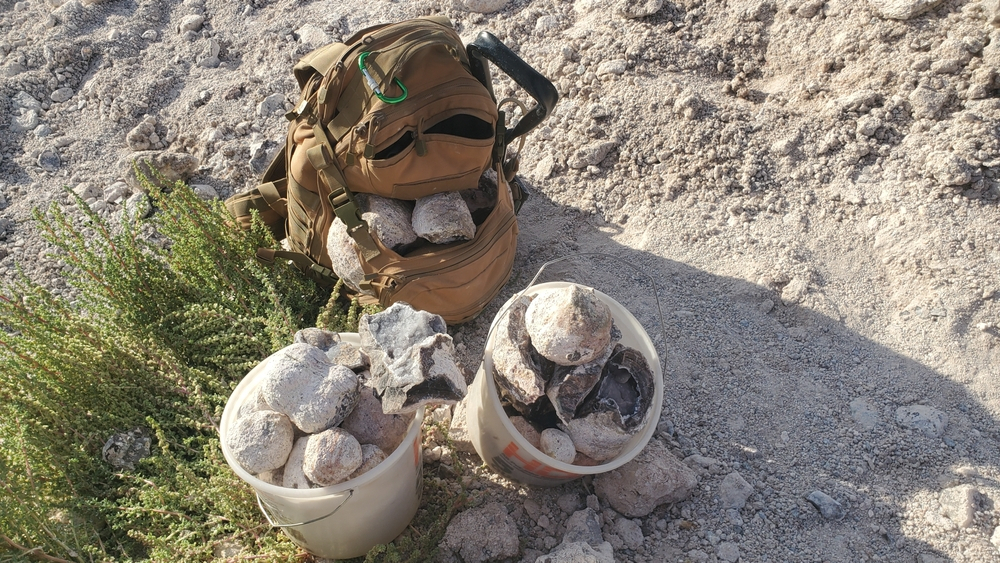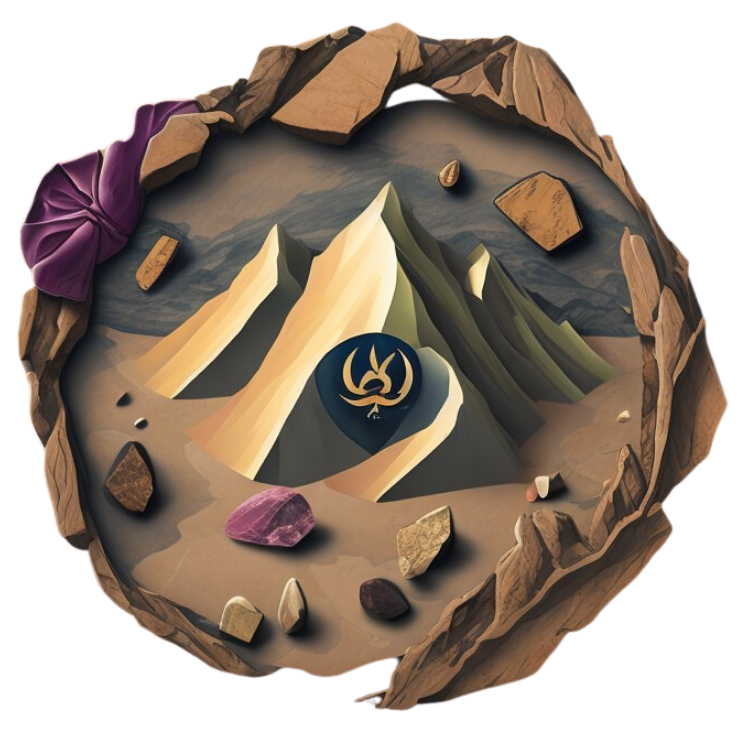Local Rockhounding: The Best Rockhounding Sites Near You
Click here to see our crystal hunting maps
Rockhounding, the adventurous pursuit of rocks, minerals, fossils, and gemstones, isn't just about the thrill of discovery - it's about connecting with our planet's geological history and natural beauty. Whether you're a seasoned collector or a curious novice, the excitement of uncovering hidden treasures lies closer than you might think! In this comprehensive guide, we'll explore how to locate the best local rockhounding sites near you.
What is Rockhounding?
Before we dive into finding the perfect spot, let's clarify what rockhounding encompasses. Essentially, it involves venturing into various environments to search for:
- Rocks: Different formations with unique compositions (igneous, sedimentary, metamorphic).
- Minerals: Naturally occurring substances with distinct chemical and crystal structures (like quartz, feldspar, or pyrite).
- Fossils: Preserved remains of prehistoric plants and animals offering glimpses into the past.
- Gemstones: Rare, beautiful minerals suitable for cutting and polishing into jewelry (such as opals, garnets, or amethyst).
Why Go Rockhounding?
Aside from the thrill of finding something unique, rockhounding offers numerous benefits:
- Connection to Nature: Spending time outdoors, and exploring diverse landscapes, fosters a deeper appreciation for the natural world.
- Educational Value: Learning about geology, mineralogy, and paleontology turns every outing into a hands-on science lesson.
- Physical Activity: Hiking, digging, and carrying finds provide healthy exercise.
- Stress Relief: The focus required and the joy of discovery can be incredibly therapeutic.
- Potential Treasures: While not guaranteed, you may uncover a valuable or fascinating specimen.
Preparing for Your Adventure

A successful rockhounding trip requires basic preparation. Here's your essential checklist:
Tools:
- Rock hammer (for breaking or testing rocks)
- Hand lens (to examine details)
- Small chisel and mallet (optional, for delicate work)
- Trowel or shovel (for digging in loose material)
- Buckets or collecting bags
- Safety goggles and gloves
Supplies:
- Water and snacks
- Sunscreen and insect repellent
- First-aid kit
- Field guide or identification app (more on this later)
- GPS or a detailed map
Where to Find the Best Rockhounding Sites
Now, let's focus on where to find those coveted rockhounding locations, especially in the United States:
Northeast
- Herkimer Diamond Mines (Herkimer, New York): Famous for double-terminated quartz crystals resembling diamonds-a truly unique find.
- Maine Mineral and Gem Museum (Bethel, Maine): While not a collecting site itself, it offers a fantastic overview of Maine's geology and helps pinpoint promising locations.
- Paterson, New Jersey: Trap rock quarries in this area yield zeolite minerals as well as fossils.
- Ruggles Mine (Grafton, New Hampshire): Seek out mica, beryl, feldspar, and other minerals at this historic mine.
Southeast
- Crater of Diamonds State Park (Murfreesboro, Arkansas): The world's only public diamond mine-you might just strike it lucky!
- Graves Mountain (Lincolnton, Georgia): Known for rutilated quartz, amethyst, and other interesting minerals.
- Jackson's Crossroads Amethyst Mine (Tignall, Georgia): Dig for your own beautiful amethyst crystals.
- Emerald Hollow Mine (Hiddenite, North Carolina): The only emerald mine in the US open to the public.
Midwest
- Mazon Creek (Illinois): World-renowned fossil site with concretions holding fossilized plant and animal life.
- Geode beds around Keokuk, Iowa: Search for those beautiful crystal-filled geodes.
- Upper Peninsula of Michigan: Agates (including Lake Superior Agates), copper, and other interesting minerals.
Southwest
- Dugway Geode Beds (Utah): Discover a variety of geodes in this popular desert location.
- Topaz Mountain (Utah): Search for well-formed topaz crystals among rhyolite rocks.
- Rockhound State Park (Deming, New Mexico): Hunt for agate, jasper, geodes, and other desert treasures.
- Glass Buttes (Oregon): Obsidian of various colors makes this a favorite for collectors.
- Spectrum Sunstone Mine (Oregon): Oregon's state gemstone, sunstone, can be found and collected here.
Northwest
- Gem Mountain Sapphire Mine (Philipsburg, Montana): Find your own Montana sapphires to be cut and polished.
- Hansen Creek (Ravensdale, Washington): Petrified wood and fossil leaves are potential finds.
- Virgin Valley (Nevada): Seek out precious fire opals in this historic opal mining area.
Public Lands: Many National Forests, Bureau of Land Management (BLM) areas, and state parks allow limited rockhounding. Be sure to check regulations and obtain permits if required.
Roadsides and Construction Sites: Freshly exposed cuts along roads or new construction sites can reveal interesting findings (exercise caution and abide by safety regulations).
Beaches and Riverbeds: Water action along beaches and riverbeds naturally sorts and concentrates various rocks, minerals, and sometimes even fossils.
Quarries and Mines: Active or abandoned quarries provide access to a wider range of rock types but often require permission and a focus on safety.
Volcanic Areas: Regions with past volcanic activity can yield obsidian, agates, and other unique formations.
Geode beds: Specific locations boast pockets of geodes - those rock formations lined with crystals.
Forested Areas: Fallen trees and exposed roots can reveal interesting specimens.
Deserts: Arid environments can preserve unique minerals and sometimes fossils.
Important Reminders:
- Always check for updates: Regulations, fees, and operational hours can change.
- Call ahead or visit websites of specific locations for current information.
- Respect guidelines and practice responsible collecting at all sites.
A more detailed information on the closest rockhounding sites near you, you can use the following resources:
- Online Resources:
- State Geological Surveys: Start with your state's geological survey website. They often have maps, guides, and information on public collecting areas.
- Websites and Forums:
- Rockhounding.org: Offers interactive maps for all 50 states.
- Mindat.org: Database with locations, minerals found, and photos.
- Rockhounding-specific forums and Facebook groups for your area.
- Guidebooks and Publications: Check your local library or bookstore for specialized rockhounding guides tailored to your region or state. Popular "Rockhounding Series" books cover many US locations.
- Rock and Mineral Clubs: Local rock and mineral clubs are fantastic resources. They organize field trips, have experienced members, and can share insights on prime spots. Search online to find clubs near you.
Rockhounding Ethics and Responsible Collecting
Before you embark on your rockhounding adventure, it's crucial to practice responsible collecting. Here's what you need to keep in mind:
- Get Permission: Always obtain permission before collecting on private property or designated areas with restrictions. Respect landowners and follow any guidelines they provide.
- Leave No Trace: Minimize your impact on the environment. Fill in any holes you dig, avoid disturbing natural features, and pack out all your trash.
- Abide by Regulations: Be aware of collecting limits and restrictions within public lands. Some areas may prohibit the removal of certain types of rocks, minerals, or fossils.
- Avoid Damaging Specimens: Use proper techniques to avoid damaging potential finds. Excessive hammering or careless extraction can ruin valuable specimens.
- Document Your Finds: Keep notes on where you found interesting rocks or minerals. This helps you learn about the local geology and potentially identify more promising locations.
Tools of the Trade: Beyond the Basics
Let's enhance your rockhounding toolkit with these optional but helpful items:
- Cracking Tools: A larger sledgehammer and heavy chisels are good for breaking down larger rocks.
- Safety Gear: Hard hats, reinforced boots, and knee pads offer added protection in potentially hazardous areas.
- Specimen Wraps: Newspaper, bubble wrap, or boxes to safely transport your treasures.
- GPS Unit: A dedicated GPS device lets you mark locations accurately for future visits.
- UV Light: For certain fluorescent minerals, a UV flashlight can reveal hidden beauty.

Identifying Your Finds
The excitement of discovery is amplified when you know exactly what you've found. Here are resources to help with identification:
- Field Guides: A specialized rock, mineral, or fossil guide for your region is incredibly helpful out in the field.
- Online Identification Apps: Applications like Rock Identifier assist with identifying specimens based on visual analysis.
- Online Databases: Websites like mindat.org provide extensive information and photos to help you compare your findings.
- Rock and Mineral Clubs: Experts in such clubs are always happy to help with identification.
Turning Finds into Treasures
Ready to elevate your raw finds? Consider these options:
- Simple Cleaning: Washing specimens with water and a soft brush often reveals their true beauty.
- Tumbling: A rock tumbler polishes rough stones, unveiling their hidden colors and patterns.
- Cutting and Polishing: For gemstones, specialized tools allow you to shape and polish them for jewelry or display.
- Local Lapidary Clubs: These clubs offer access to equipment, workshops, and expertise in turning your finds into works of art.
Additional Tips for Rockhounding Success
- Research: Learn basic geology and mineralogy for your area to narrow down likely hotspots.
- Partner Up: Join a friend or club for extra eyes, assistance, and a sense of camaraderie.
- Start Simple: Begin with easily accessible sites to ease into the hobby and build your skills.
- Weather: Check conditions beforehand and dress appropriately for the environment.
- Patience: Don't get discouraged-sometimes the best finds take time and exploration.
Local Rockhounding is Just the Beginning
Think of local rockhounding as your gateway to the broader world of geology and earth sciences. As your knowledge and passion grow, you might find yourself venturing further to specialized rockhounding destinations known for unique discoveries.
The beauty of this hobby lies in the ongoing sense of wonder and excitement. Each outing has the potential to reveal a new piece of Earth's incredible story held within the rocks beneath your feet. So, gear up, get informed, and let the adventure unfold!
